sensor ASTON MARTIN V8 VANTAGE 2010 Owners Manual
[x] Cancel search | Manufacturer: ASTON MARTIN, Model Year: 2010, Model line: V8 VANTAGE, Model: ASTON MARTIN V8 VANTAGE 2010Pages: 947, PDF Size: 43.21 MB
Page 417 of 947
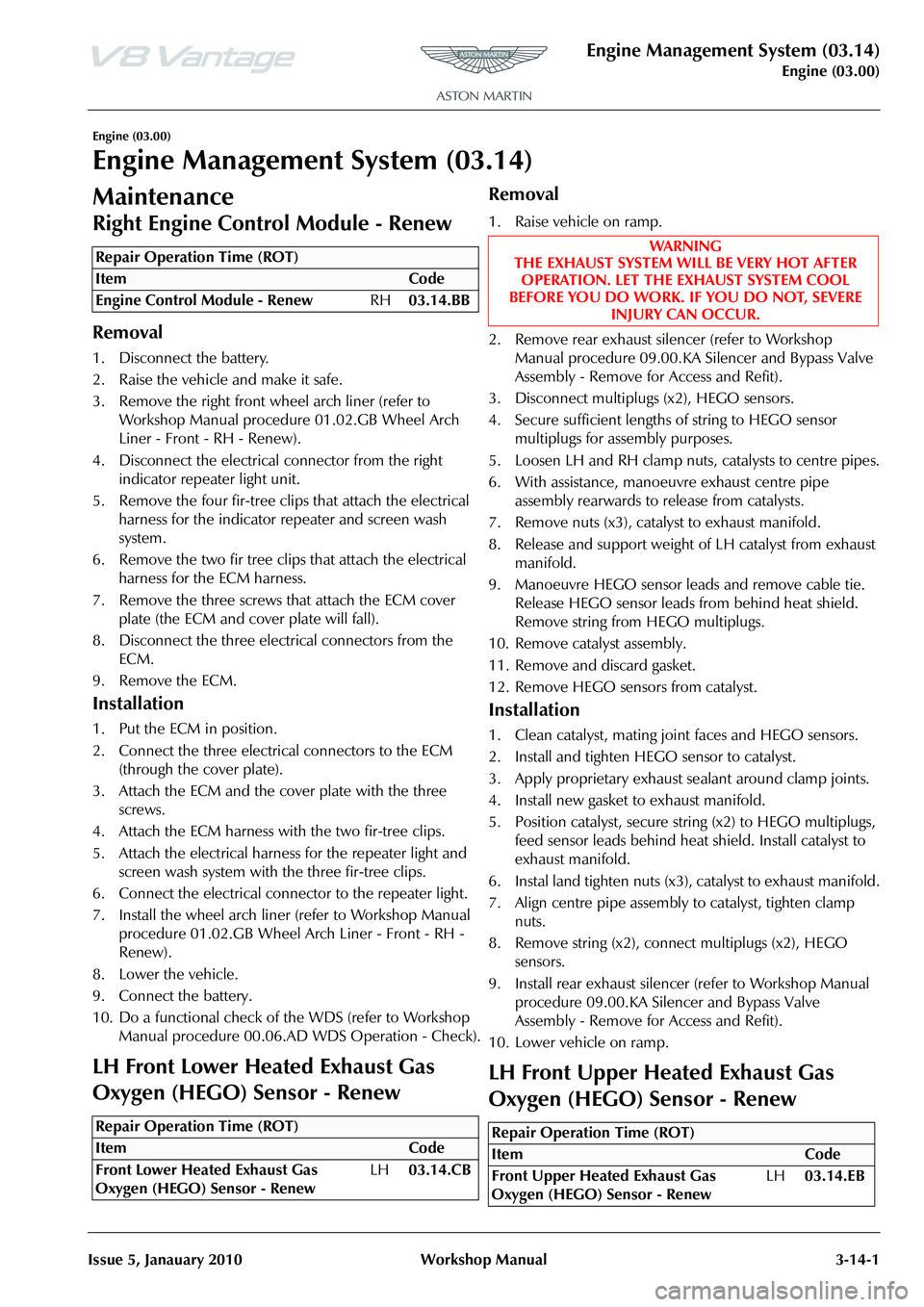
Engine Management System (03.14)
Engine (03.00)
Issue 5, Janauary 2010 Workshop Manual 3-14-1
Engine (03.00)
Engine Management System (03.14)
Maintenance
LH Front Lower Heated Exhaust Gas
Oxygen (HEGO) Sensor - Renew
Removal
1. Raise vehicle on ramp.
2. Remove rear exhaust silencer (refer to Workshop Manual procedure 09.00.KA Silencer and Bypass Valve
Assembly - Remo ve for Access and Refit).
3. Disconnect multiplugs (x2), HEGO sensors.
4. Secure sufficient lengths of string to HEGO sensor multiplugs for assembly purposes.
5. Loosen LH and RH clamp nuts, catalysts to centre pipes.
6. With assistance, manoeuvre exhaust centre pipe assembly rearwards to release from catalysts.
7. Remove nuts (x3), catalyst to exhaust manifold.
8. Release and support weight of LH catalyst from exhaust
manifold.
9. Manoeuvre HEGO sensor leads and remove cable tie. Release HEGO sensor leads from behind heat shield.
Remove string from HEGO multiplugs.
10. Remove catalyst assembly.
11. Remove and discard gasket.
12. Remove HEGO sens ors from catalyst.
Installation
1. Clean catalyst, mating joint faces and HEGO sensors.
2. Install and tighten HEGO sensor to catalyst.
3. Apply proprietary exhaust se alant around clamp joints.
4. Install new gasket to exhaust manifold.
5. Position catalyst, secure string (x2) to HEGO multiplugs, feed sensor leads behind heat shield. Install catalyst to
exhaust manifold.
6. Instal land tighten nuts (x3), catalyst to exhaust manifold.
7. Align centre pipe assembly to catalyst, tighten clamp
nuts.
8. Remove string (x2), conne ct multiplugs (x2), HEGO
sensors.
9. Install rear exhaust silencer (refer to Workshop Manual procedure 09.00.KA Silencer and Bypass Valve
Assembly - Remo ve for Access and Refit).
10. Lower vehicle on ramp.
LH Front Upper Heated Exhaust Gas
Oxygen (HEGO) Sensor - Renew
Repair Operation Time (ROT)
Repair Operation Time (ROT)
WA R N I N G
THE EXHAUST SYSTEM WILL BE VERY HOT AFTER OPERATION. LET THE EXHAUST SYSTEM COOL
BEFORE YOU DO WORK. IF YOU DO NOT, SEVERE
INJURY CAN OCCUR.
Repair Operation Time (ROT)
Page 418 of 947
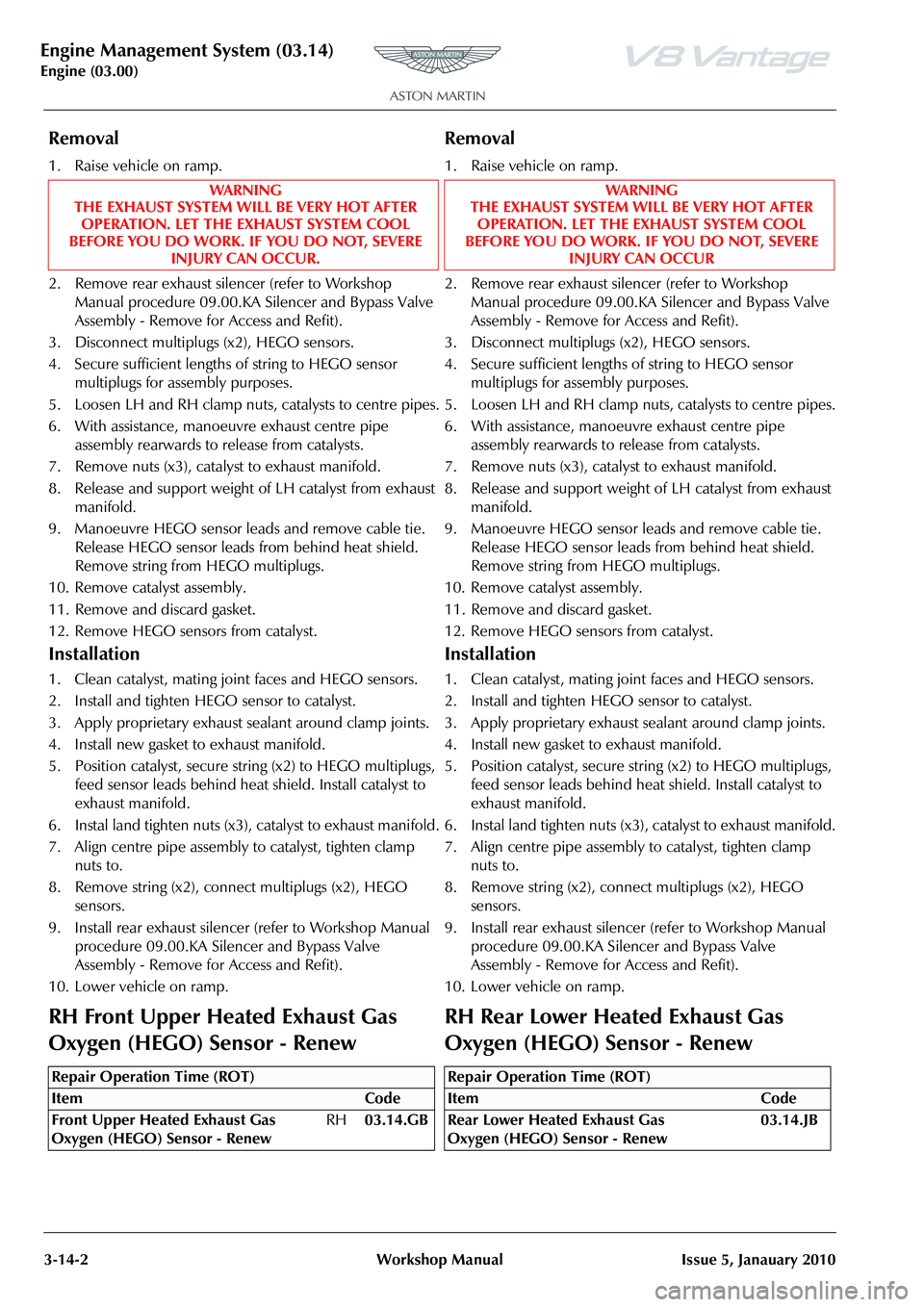
Engine Management System (03.14)
Engine (03.00)3-14-2 Workshop Manual Issue 5, Janauary 2010
Removal
1. Raise vehicle on ramp.
2. Remove rear exhaust silencer (refer to Workshop Manual procedure 09.00.KA Silencer and Bypass Valve
Assembly - Remove for Access and Refit).
3. Disconnect multiplugs (x2), HEGO sensors.
4. Secure sufficient lengths of string to HEGO sensor multiplugs for assembly purposes.
5. Loosen LH and RH clamp nuts, catalysts to centre pipes.
6. With assistance, manoeuvre exhaust centre pipe assembly rearwards to release from catalysts.
7. Remove nuts (x3), catalyst to exhaust manifold.
8. Release and support weight of LH catalyst from exhaust manifold.
9. Manoeuvre HEGO sensor leads and remove cable tie. Release HEGO sensor leads from behind heat shield.
Remove string from HEGO multiplugs.
10. Remove catalyst assembly.
11. Remove and discard gasket.
12. Remove HEGO sensors from catalyst.
Installation
1. Clean catalyst, mating joint faces and HEGO sensors.
2. Install and tighten HEGO sensor to catalyst.
3. Apply proprietary exhaust sealant around clamp joints.
4. Install new gasket to exhaust manifold.
5. Position catalyst, secure string (x2) to HEGO multiplugs, feed sensor leads behind heat shield. Install catalyst to
exhaust manifold.
6. Instal land tighten nuts (x3), catalyst to exhaust manifold.
7. Align centre pipe assembly to catalyst, tighten clamp nuts to.
8. Remove string (x2), connect multiplugs (x2), HEGO sensors.
9. Install rear exhaust silencer (refer to Workshop Manual
procedure 09.00.KA Silencer and Bypass Valve
Assembly - Remove for Access and Refit).
10. Lower vehicle on ramp.
RH Front Upper Heated Exhaust Gas
Oxygen (HEGO) Sensor - Renew
Removal
1. Raise vehicle on ramp.
2. Remove rear exhaust silencer (refer to Workshop Manual procedure 09.00.KA Silencer and Bypass Valve
Assembly - Remove for Access and Refit).
3. Disconnect multiplugs (x2), HEGO sensors.
4. Secure sufficient lengths of string to HEGO sensor
multiplugs for assembly purposes.
5. Loosen LH and RH clamp nuts, catalysts to centre pipes.
6. With assistance, manoeuvre exhaust centre pipe assembly rearwards to release from catalysts.
7. Remove nuts (x3), catalyst to exhaust manifold.
8. Release and support weight of LH catalyst from exhaust
manifold.
9. Manoeuvre HEGO sensor leads and remove cable tie. Release HEGO sensor leads from behind heat shield.
Remove string from HEGO multiplugs.
10. Remove catalyst assembly.
11. Remove and discard gasket.
12. Remove HEGO sensors from catalyst.
Installation
1. Clean catalyst, mating joint faces and HEGO sensors.
2. Install and tighten HEGO sensor to catalyst.
3. Apply proprietary exhaust sealant around clamp joints.
4. Install new gasket to exhaust manifold.
5. Position catalyst, secure string (x2) to HEGO multiplugs, feed sensor leads behind heat shield. Install catalyst to
exhaust manifold.
6. Instal land tighten nuts (x3), catalyst to exhaust manifold.
7. Align centre pipe assembly to catalyst, tighten clamp nuts to.
8. Remove string (x2), connect multiplugs (x2), HEGO sensors.
9. Install rear exhaust silencer (refer to Workshop Manual procedure 09.00.KA Silencer and Bypass Valve
Assembly - Remove for Access and Refit).
10. Lower vehicle on ramp.
RH Rear Lower Heated Exhaust Gas
Oxygen (HEGO) Sensor - Renew
WAR NI NG
THE EXHAUST SYSTEM WILL BE VERY HOT AFTER OPERATION. LET THE EXHAUST SYSTEM COOL
BEFORE YOU DO WORK. IF YOU DO NOT, SEVERE INJURY CAN OCCUR.
Repair Operation Time (ROT)
WAR NI NG
THE EXHAUST SYSTEM WILL BE VERY HOT AFTER OPERATION. LET THE EXHAUST SYSTEM COOL
BEFORE YOU DO WORK. IF YOU DO NOT, SEVERE INJURY CAN OCCUR
Repair Operation Time (ROT)
ItemCode
Rear Lower Heated Exhaust Gas
Oxygen (HEGO) Sensor - Renew 03.14.JB
Page 419 of 947
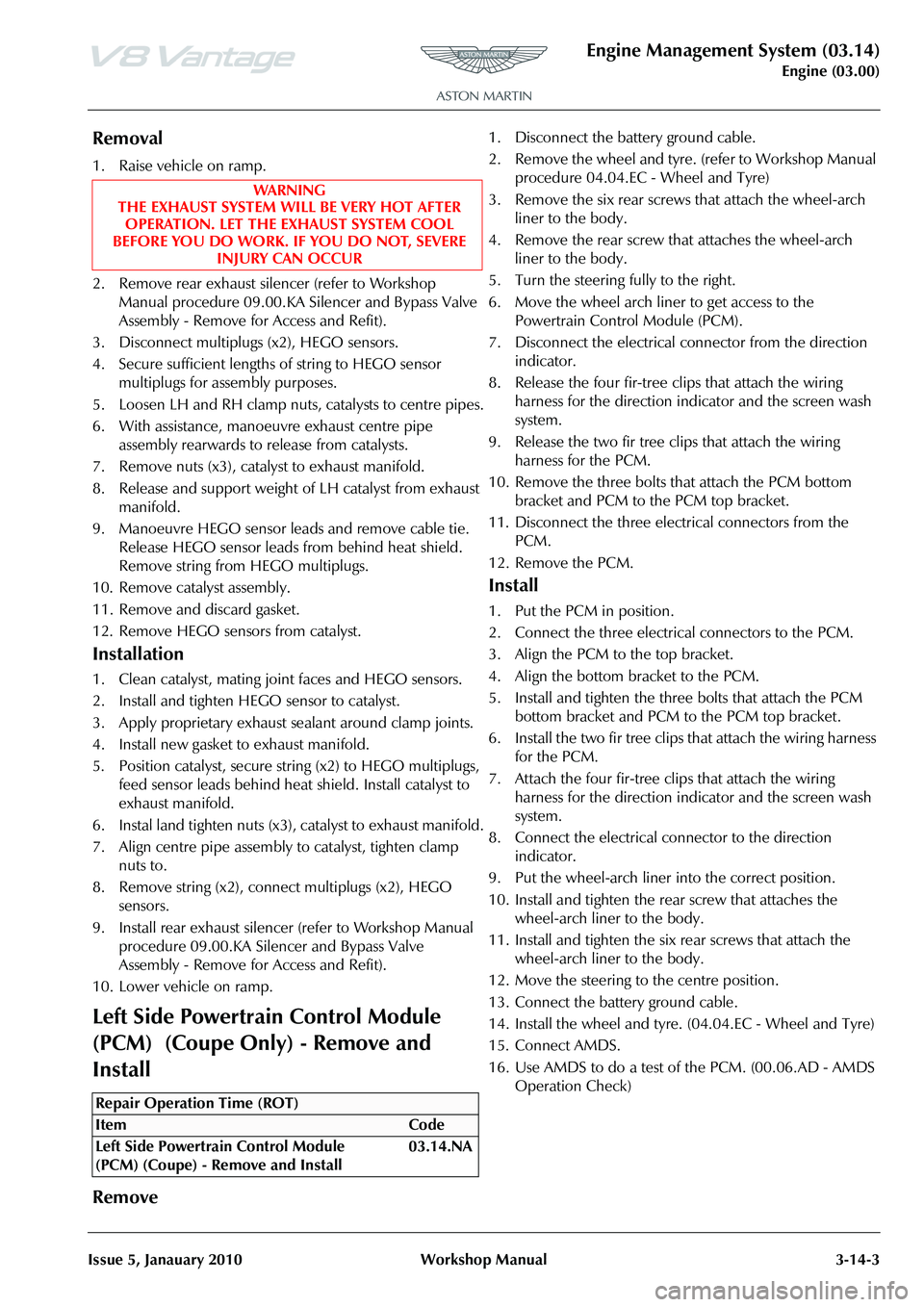
Engine Management System (03.14)
Engine (03.00)
Issue 5, Janauary 2010 Workshop Manual 3-14-3
Removal
1. Raise vehicle on ramp.
2. Remove rear exhaust silencer (refer to Workshop Manual procedure 09.00.KA Silencer and Bypass Valve
Assembly - Remove for Access and Refit).
3. Disconnect multiplugs (x2), HEGO sensors.
4. Secure sufficient lengths of string to HEGO sensor multiplugs for assembly purposes.
5. Loosen LH and RH clamp nuts, catalysts to centre pipes.
6. With assistance, manoeuvre exhaust centre pipe assembly rearwards to release from catalysts.
7. Remove nuts (x3), catalyst to exhaust manifold.
8. Release and support weight of LH catalyst from exhaust manifold.
9. Manoeuvre HEGO sensor leads and remove cable tie. Release HEGO sensor leads from behind heat shield.
Remove string from HEGO multiplugs.
10. Remove catalyst assembly.
11. Remove and discard gasket.
12. Remove HEGO sensors from catalyst.
Installation
1. Clean catalyst, mating joint faces and HEGO sensors.
2. Install and tighten HEGO sensor to catalyst.
3. Apply proprietary exhaust se alant around clamp joints.
4. Install new gasket to exhaust manifold.
5. Position catalyst, secure string (x2) to HEGO multiplugs, feed sensor leads behind heat shield. Install catalyst to
exhaust manifold.
6. Instal land tighten nuts (x3), catalyst to exhaust manifold.
7. Align centre pipe assembly to catalyst, tighten clamp
nuts to.
8. Remove string (x2), conne ct multiplugs (x2), HEGO
sensors.
9. Install rear exhaust silencer (refer to Workshop Manual procedure 09.00.KA Silencer and Bypass Valve
Assembly - Remove for Access and Refit).
10. Lower vehicle on ramp.
Left Side Powertrain Control Module
(PCM) (Coupe Only) - Remove and
Install
Remove
1. Disconnect the ba ttery ground cable.
2. Remove the wheel and tyre. (refer to Workshop Manual procedure 04.04.EC - Wheel and Tyre)
3. Remove the six rear screws that attach the wheel-arch liner to the body.
4. Remove the rear screw that attaches the wheel-arch liner to the body.
5. Turn the steering fully to the right.
6. Move the wheel arch liner to get access to the Powertrain Control Module (PCM).
7. Disconnect the electrical connector from the direction
indicator.
8. Release the four fi r-tree clips that attach the wiring
harness for the direction indi cator and the screen wash
system.
9. Release the two fir tree clips that attach the wiring harness for the PCM.
10. Remove the three bolts that attach the PCM bottom bracket and PCM to the PCM top bracket.
11. Disconnect the three electrical connectors from the PCM.
12. Remove the PCM.
Install
1. Put the PCM in position.
2. Connect the three electrical connectors to the PCM.
3. Align the PCM to the top bracket.
4. Align the bottom bracket to the PCM.
5. Install and tighten the three bolts that attach the PCM bottom bracket and PCM to the PCM top bracket.
6. Install the two fir tree clips that attach the wiring harness for the PCM.
7. Attach the four fir-tree cl ips that attach the wiring
harness for the direction indi cator and the screen wash
system.
8. Connect the electrical connector to the direction indicator.
9. Put the wheel-arch liner into the correct position.
10. Install and tighten the rear screw that attaches the wheel-arch liner to the body.
11. Install and tighten the six rear screws that attach the wheel-arch liner to the body.
12. Move the steering to the centre position.
13. Connect the battery ground cable.
14. Install the wheel and tyre. (04.04.EC - Wheel and Tyre)
15. Connect AMDS.
16. Use AMDS to do a test of the PCM. (00.06.AD - AMDS Operation Check)
WA R N I N G
THE EXHAUST SYSTEM WILL BE VERY HOT AFTER OPERATION. LET THE EXHAUST SYSTEM COOL
BEFORE YOU DO WORK. IF YOU DO NOT, SEVERE
INJURY CAN OCCUR
Repair Operation Time (ROT)
Page 421 of 947

Throttle Control (03.16)
Engine (03.00)
May 2007 Workshop Manual 3-15-1
Engine (03.00)
Throttle Control (03.16)
Description
Motorised Throttles
The motorised throttle allows accurate control
of the inlet air.
A throttle position sensor (TPS) is incorporated
into the throttle unit. During normal engine
run, TPS signals are used by the PCM to
indicate power demand from the engine. If not
already at the desired position, the PCM will
drive the throttle motor to open or close the
throttle by the required amount.
At idle, the throttle butterfly is almost closed
and idle speed is controlled by small throttle
movements.
The throttle butterfly is spring loaded to fail in
the idle position. In the event of the throttle
butterfly spring failing, air flow will allow the
throttle butterflies to fail in the idle position.
No set-up procedure is required.
Page 425 of 947
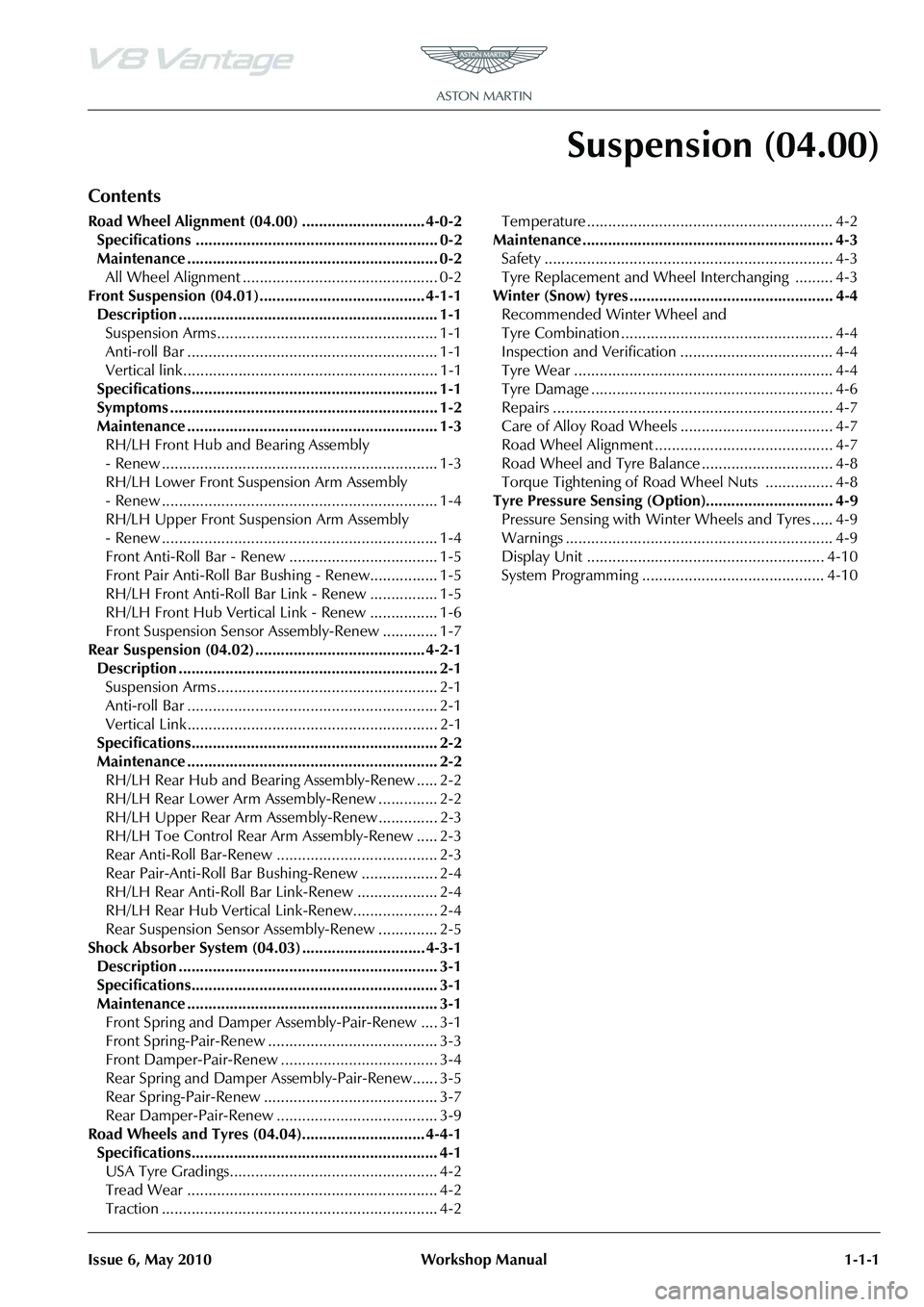
Issue 6, May 2010 Workshop Manual 1-1-1
Suspension (04.00)
Contents
Road Wheel Alignment (04.00) ............................. 4-0-2Specifications ......................................................... 0-2
Maintenance ........................................................... 0-2All Wheel Alignment .............................................. 0-2
Front Suspension (04.01)....................................... 4-1-1 Description ............................................................. 1-1Suspension Arms .................................................... 1-1
Anti-roll Bar ........................................................... 1-1
Vertical link............................................................ 1-1
Specifications.......................................................... 1-1
Symptoms ............................................................... 1-2
Maintenance ........................................................... 1-3 RH/LH Front Hub and Bearing Assembly
- Renew ................................................................. 1-3
RH/LH Lower Front Suspension Arm Assembly
- Renew ................................................................. 1-4
RH/LH Upper Front Suspension Arm Assembly
- Renew ................................................................. 1-4
Front Anti-Roll Bar - Renew ................................... 1-5
Front Pair Anti-Roll Bar Bushing - Renew................ 1-5
RH/LH Front Anti-Roll Bar Link - Renew ................ 1-5
RH/LH Front Hub Vertical Link - Renew ................ 1-6
Front Suspension Sensor Assembly-Renew ............. 1-7
Rear Suspension (04.02) ........................................ 4-2-1 Description ............................................................. 2-1Suspension Arms .................................................... 2-1
Anti-roll Bar ........................................................... 2-1
Vertical Link........................................................... 2-1
Specifications.......................................................... 2-2
Maintenance ........................................................... 2-2 RH/LH Rear Hub and Bearin g Assembly-Renew ..... 2-2
RH/LH Rear Lower Arm Assembly-Renew .............. 2-2
RH/LH Upper Rear Arm Assembly-Renew .............. 2-3
RH/LH Toe Control Rear Arm Assembly-Renew ..... 2-3
Rear Anti-Roll Bar-Renew ...................................... 2-3
Rear Pair-Anti-Roll Bar Bushing-Renew .................. 2-4
RH/LH Rear Anti-Roll Bar Link-Renew ................... 2-4
RH/LH Rear Hub Vertical Link-Renew.................... 2-4
Rear Suspension Sensor Assembly-Renew .............. 2-5
Shock Absorber System (04.03) ............................. 4-3-1 Description ............................................................. 3-1
Specifications.......................................................... 3-1
Maintenance ........................................................... 3-1Front Spring and Damper Assembly-Pair-Renew .... 3-1
Front Spring-Pair-Renew ........................................ 3-3
Front Damper-Pair-Renew ..................................... 3-4
Rear Spring and Damper Assembly-Pair-Renew...... 3-5
Rear Spring-Pair-Renew ......................................... 3-7
Rear Damper-Pair-Renew ...................................... 3-9
Road Wheels and Tyres (04.04)............................. 4-4-1 Specifications.......................................................... 4-1USA Tyre Gradings................................................. 4-2
Tread Wear ........................................................... 4-2
Traction ................................................................. 4-2 Temperature .......................................................... 4-2
Maintenance ........................................................... 4-3 Safety .................................................................... 4-3
Tyre Replacement and Wheel Interchanging ......... 4-3
Winter (Snow) tyres ................................................ 4-4 Recommended Winter Wheel and
Tyre Combination .................................................. 4-4
Inspection and Verification . ................................... 4-4
Tyre Wear ............................................................. 4-4
Tyre Damage ......................................................... 4-6
Repairs .................................................................. 4-7
Care of Alloy Road Wheels .................................... 4-7
Road Wheel Alignment .......................................... 4-7
Road Wheel and Tyre Balance ............................... 4-8
Torque Tightening of Road Wheel Nuts ................ 4-8
Tyre Pressure Sensing (Option).............................. 4-9 Pressure Sensing with Wint er Wheels and Tyres ..... 4-9
Warnings ............................................................... 4-9
Display Unit ........................................................ 4-10
System Programming ........................................... 4-10
Page 427 of 947

Front Suspension (04.01)
Suspension (04.00)
November 2008 Workshop Manual 4-1-1
Suspension (04.00)
Front Suspension (04.01)
Description
Suspension Arms
The upper suspension arm is attached to the body structure.
The lower suspension arm is attached to the front subframe.
Each upper suspension arm has a press-fit ball-joint, and two
interleaved rubber bushes. Two bolts attach the upper
suspension arm to the body structure.
Each lower suspension arm has a press fit ball-joint and
metal-to-rubber bonded bushes which are attached to the
front subframe by two eccentric cam bolts (Camber and
castor settings).
Anti-roll Bar
The anti-roll bar, is attached to the subframe in two positions
by rubber bushes and clamps. The outer ends of the anti-roll
bar are attached to the lower suspension arms by drop links.
The anti-roll bar provides the required stiffness to control
body roll.
Vertical link
The Vertical link (Knuckle Joint) swivels on the upper and
lower suspension arms via ball-joints, and carries the hub, a
unit 3 wheel bearing (including the ABS encoder ring), the
wheel speed sensor, the brake caliper, and the brake disc
and shield. The position of the Vertical link is determined by
the movement of the steering rack, which is connected to
the Vertical link by the steering track rod.
Specifications
Upper Arm Ball Joint
and Bushes
Ball Joint
and Bushes Verticle
Link
Bolts to Body
Lower Arm
Anti-roll Bar Drop Links
Eccentric
Cam Bolts
04-01-003
Torque Figures
DescriptionNmlb. / ft.
Brake dust shield. 9 7
Bearing Assembly to the Vertical
link. 55 41
Vertical Link to the Lower
Suspension Arm. 90 66.5
Vertical Link to the Upper
Suspension Arm. 90 66.5
Track-rod End Lock Nut. 70 52
Vehicle Ride Height Sensor. M8 M522.5
9 17
7
Anti-roll Bar Link Nuts 110 81.5
Anti-roll Bar Mounting Bolts
Torque bolt 1, then bolt 2, then
bolt 1 again (to allow for rubber
compression) 22.5 17
Torque the following suspensi on fixings with the vehicle
at normal ride height
Lower Suspension Arm front
bush to the Subframe M14 185 137
Lower Suspension Arm rear
bush to the Subframe. M12 115 85
Upper Suspension Arm to the
Front Structure 115 85
Spring and Damper Bolts Top Lower22.5
175 17
129.5
Normal ride height 2 x 37.5kg in front seats (37.5kg in
each seat) plus a full fuel tank.
Page 429 of 947
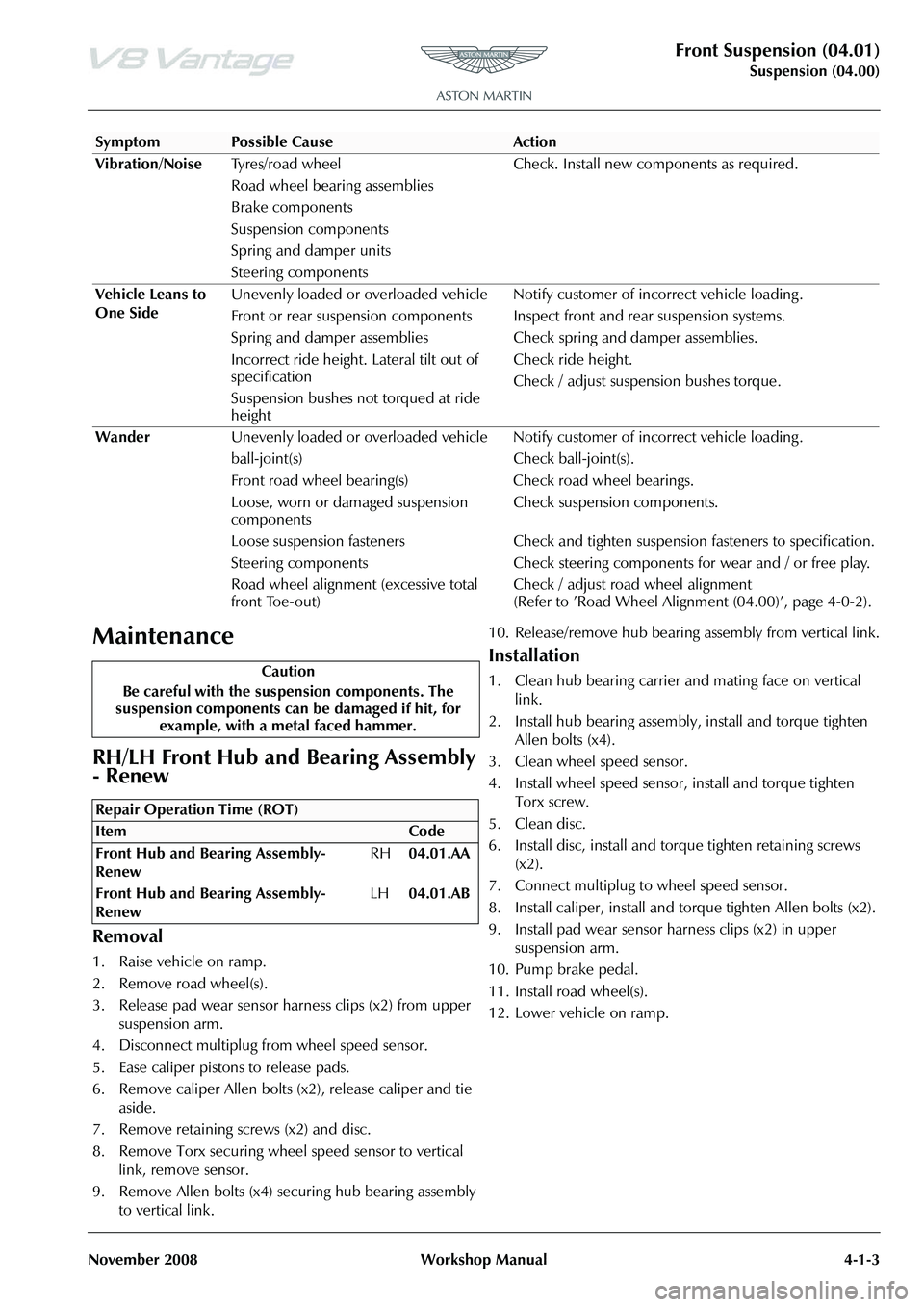
Front Suspension (04.01)
Suspension (04.00)
November 2008 Workshop Manual 4-1-3
Maintenance
RH/LH Front Hub and Bearing Assembly
- Renew
Removal
1. Raise vehicle on ramp.
2. Remove road wheel(s).
3. Release pad wear sensor harness clips (x2) from upper suspension arm.
4. Disconnect multiplug from wheel speed sensor.
5. Ease caliper pistons to release pads.
6. Remove caliper Allen bolts (x2), release caliper and tie
aside.
7. Remove retaining screws (x2) and disc.
8. Remove Torx securing wheel speed sensor to vertical link, remove sensor.
9. Remove Allen bolts (x4) securing hub bearing assembly to vertical link. 10. Release/remove hub bearing assembly from vertical link.
Installation
1. Clean hub bearing carrier and mating face on vertical
link.
2. Install hub bearing assembly, install and torque tighten Allen bolts (x4).
3. Clean wheel speed sensor.
4. Install wheel speed sensor, install and torque tighten Torx screw.
5. Clean disc.
6. Install disc, install and torque tighten retaining screws (x2).
7. Connect multiplug to wheel speed sensor.
8. Install caliper, install and to rque tighten Allen bolts (x2).
9. Install pad wear sensor harness clips (x2) in upper suspension arm.
10. Pump brake pedal.
11. Install road wheel(s).
12. Lower vehicle on ramp.
Vibration/Noise
Tyres/road wheel
Road wheel bearing assemblies
Brake components
Suspension components
Spring and damper units
Steering components Check. Install new components as required.
Vehicle Leans to
One Side Unevenly loaded or overloaded vehicle Notif
y customer of incorrect vehicle loading .
Front or rear suspension components Inspect front and rear suspension systems.
Spring and damper assemblies Check spring and damper assemblies.
Incorrect ride height. Lateral tilt out of
specification
Suspension bushes not torqued at ride
height Check ride height.
Check / adjust suspension bushes torque.
Wander Unevenly loaded or overloaded vehicle Notif y customer of incorrect vehicle loading .
ball-joint(s) Check ball-joint(s).
Front road wheel bearing(s) Check road wheel bearings.
Loose, worn or damaged suspension
components Check suspension components.
Loose suspension fasteners Check and tighten suspension fasteners to specification.
Steering components Check steering components for wear and / or free play.
Road wheel alignment (excessive total
front Toe-out) Check / adjust road wheel alignment
(Refer to ’Road Wheel Alignment (04.00)’, page 4-0-2).
SymptomPossible CauseAction
Caution
Be careful with the suspension components. The
suspension components can be damaged if hit, for example, with a metal faced hammer.
Repair Operation Time (ROT)
Page 430 of 947

Front Suspension (04.01)
Suspension (04.00)4-1-4 Workshop Manual November 2008
RH/LH Lower Front Suspension Arm
Assembly - Renew
Removal
1. Raise vehicle on ramp.
2. Remove road wheel(s).
3. Remove nut/washer securing anti-roll bar link to lower suspension, release link from arm.
4. Remove nut/bolt securing damper to lower suspension arm, release damper from mounting.
5. Remove nut securing lower suspension arm ball-joint to vertical link.
6. Install tool (204 - 523) ba ll-joint remover and release
lower suspension ball-joi nt from vertical link.
7. Mark fitted positions of cam washers on lower suspension arm inner fixings to aid assembly purpose.
8. Remove nuts/bolts, cam washers (x2), securing lower suspension arm to subframe.
9. Release/remove lower suspension arm from subframe and vertical link.
Installation
1. Clean lower suspension arm and mating faces on vertical link and subframe
2. Install lower suspension arm in subframe.
3. Install cam washers, bolts/nuts (x2). Align cam washers to marks. Do not torque tighten at this stage.
4. Install lower suspension arm ball-joint in vertical link. Install and torque tighten nut.
5. Align damper to mounting, install bolt/nut. Do not torque tighten at this stage.
6. Install anti-roll bar link, install washer/nut. Do not torque tighten at this stage.
7. Final tightening of suspen sion components must be
carried out with the suspensi on arms at normal ride
height.
8. Install road wheel(s).
9. Lower vehicle on ramp.
10. Torque tighten suspension nuts/bolts.
11. 4 wheel alignment - check/adjust (see Workshop Manual procedure 04.00.AD 4 Wheel Alignment -
Check and Adjust).
RH/LH Upper Front Suspension Arm
Assembly - Renew
Removal
1. Raise the vehicle and make it safe.
2. Remove the road wheel for the applicable suspension arm.
3. Disconnect the electrical connector from the ABS sensor.
4. Release the three sensor harness clips from the upper suspension arm and the vertical link.
5. Remove the two Torx screws that attach the engine cross brace to the mounting.
6. Remove the two nuts and two bolts that attach the upper suspension arm to the body.
7. Release the suspension arm from the body.
8. Remove the three nuts that attach the damper top mounting.
9. Remove the mounting for the engine cross brace.
10. Remove the nut and bolt that attaches the damper to its lower mounting.
11. Remove spring/damper assembly.
12. Remove the nut that attaches the ball-joint for the upper suspension arm to the vertical link.
13. Install tool (204 - 523 - ball-joint remover) and release the ball-joint from vertical link.
14. Remove the upper suspension arm assembly.
Installation
1. Clean the upper suspension arm and the mating faces on the body and the vertical link.
2. Install the upper suspension arm to vertical link. Install the nut but do not torque tighten at this step.
3. Install spring/damper assembly.
4. Install the cross-brace support.
5. Install the three nuts but do not torque tighten at this step.
6. Align the damper to the lower mounting, install bolt/nut. Do not torque tighten at this step.
7. Put the upper suspension arm in positionon the body.
8. Install bolts and nuts but do not torque tighten at this step.
9. Connect the electrical connector to the ABS sensor.
Repair Operation Time (ROT)Repair Operation Time (ROT)
ItemCode
Upper Front Suspension Arm
Assembly-Renew RH
04.01.AE
Upper Front Suspension Arm
Assembly-Renew LH
04.01.AF
Caution
Be carefulthat you do not damage the ball-joint rubber
boot when you use the special tool.
Page 431 of 947

Front Suspension (04.01)
Suspension (04.00)
November 2008 Workshop Manual 4-1-5
10. Install the three sensor harness clips in the upper suspension and the vertical link.
11. Install the road wheel.
12. Lower the vehicle on ramp.
13. Do an all-wheel alignment procedure (Refer to ’All
Wheel Alignment’, page 4-0-2).
14. Torque tighten suspension nuts and bolts.
15. Align engine cross brace to support, install and torque tighten Torx bolts (x2).
Front Anti-Roll Bar - Renew
Removal
1. Raise vehicle on ramp.
2. Remove road wheel(s).
3. Remove front undertray (see Workshop Manual procedure 01.02.NB Undertray - Front - Renew).
4. Remove nuts and washers (x2), anti-roll bar to drop links.
5. Remove bolts (x4), straps (x2).
6. Remove anti-roll bar.
7. Remove bushes (x2) from anti-roll bar.
Installation
1. Clean anti-roll bar, bushes and straps.
2. Install bushes (x2) on anti-roll bar.
3. Position anti-roll bar, align bushes (x2), install straps (x2), install bolts (x4). Do not torque tighten.
4. Install drop links to anti-roll bar, install nuts/washers (x2).
Do not torque tighten.
5. Install front undertray (see Workshop Manual procedure 01.02.NB Undertray - Front - Renew).
6. Lower vehicle in ramp.
7. Torque tighten link nuts (x4).
8. Torque tighten bush strap bolts (x4).
Front Pair Anti-Roll Bar Bushing - Renew
Removal
1. Raise vehicle on ramp.
2. Remove front undertray (see Workshop Manual procedure 01.02.NB Undertray - Front - Renew).
3. Remove bolts (x4) securing anti-roll bar bush straps to subframe.
4. Release/remove bush straps.
5. Remove bushes (x2) from anti-roll bar.
Installation
1. Clean anti-roll bar and bush straps.
2. Install bushes on to anti-roll bar.
3. Install bush straps (x2), install bolts (x4). Do not torque tighten at this stage.
4. Install front undertray (see Workshop Manual procedure 01.02.NB Undertray - Front - Renew).
5. Lower vehicle on ramp.
6. Torque tighten all suspension nuts/bolts.
RH/LH Front Anti-Roll Bar Link - Renew
Removal
1. Raise vehicle on ramp.
2. Remove road wheel(s).
3. Remove nut/bolt securing damper to lower suspension
arm.
4. Release damper from mounting sufficient to remove top anti-roll bar link.
5. Remove nuts and washers (x2) , link to lower suspension
arm and anti-roll bar.
6. Release and remove anti-roll bar link.
Installation
1. Clean anti-roll bar link and mating faces on lower suspension arm and anti-roll bar.
2. Install link to anti-roll bar and lower suspension arm.
3. Install washers (x2) and nuts (x2). Do not torque tighten.
Caution
Do not fully tighten the nuts and bolts on the suspension
components. Only tighten the nuts and bolts of the
suspension components when the suspension arms are
at their usual ride-height and you have adjusted the
geometry. If you do not do this, the suspension bushes
will have too much stress when the suspension is moved
to its maximum upward travel.
Repair Operation Time (ROT)
Repair Operation Time (ROT)
Repair Operation Time (ROT)
Page 432 of 947

Front Suspension (04.01)
Suspension (04.00)4-1-6 Workshop Manual November 2008
4. Align damper to lower mounting, install bolt/nut. Do not torque tighten at this stage.
5. Install road wheel(s).
6. Lower vehicle in ramp.
7. Torque tighten link nuts (x2).
8. Torque tighten lower damper bolt.RH/LH Front Hub Vertical Link - Renew
Removal
1. Raise vehicle on ramp.
2. Remove road wheel(s).
3. Install tool (204 - 524) on front hub, install and tighten wheel nuts.
4. Lower vehicle to raise suspension sufficient to install ball-joint removing tool (204 - 523).
5. Remove track rod end from vertical link (using tool 204- 523).
6. Remove pad wear sensors.
7. Remove ABS sensor multiplug.
8. Remove Torx screw securing ABS sensor, remove sensor.
9. Ease caliper pistons to release pads.
10. Remove caliper Allen bolts (x2), release caliper and tie caliper aside.
11. Remove brake disc Torx screws (x2), remove disc.
12. Release lower suspension arm from vertical link (using tool 204-523).
13. Release vertical link from upper suspension arm (using tool 204-523). Remove vertical link assembly.
14. Remove Allen bolts (x4) se curing hub bearing assembly
to vertical link.
15. Release/remove hub bearing a ssembly from vertical link.
16. Remove Torx screws (x4), di sc shield to vertical link.
Remove shield.
Installation
1. Clean vertical link, hub bearing carrier and disc shield.
2. Position disc shield to vertical link, install and torque tighten Torx screws (x4).
3. Install hub bearing assembly in vertical link, install Allen
bolts (x4) and tighten.
4. Install vertical link assembly to upper suspension arm. Install and torque tighten nut.
5. Install vertical link in lowe r suspension arm. Install and
torque tighten nut.
6. Clean brake disc.
7. Install brake disc. Install an d torque tighten Torx screws
(x2).
Caution
Do not fully tighten the nuts and bolts on the suspension
components. Only tighten th e nuts and bolts of the
suspension components when the suspension arms are
at their usual ride-height and you have adjusted the
geometry. If you do not do this, the suspension bushes
will have too much stress when the suspension is moved
to its maximum upward travel.
Repair Operation Time (ROT)
ItemCode
Front Hub Vertical Link-Renew RH04.01.CB
Front Hub Vertical Link-Renew LH04.01.DB
Caution
Do not fully tighten the nuts and bolts on the suspension
components. Only tighten the nuts and bolts of the
suspension components when the suspension arms are
at their usual ride-height and you have adjusted the
geometry. If you do not do this, the suspension bushes
will have too much stress when the suspension is moved
to its maximum upward travel.